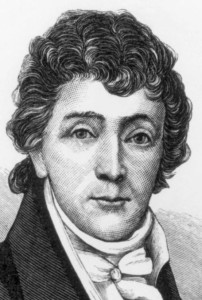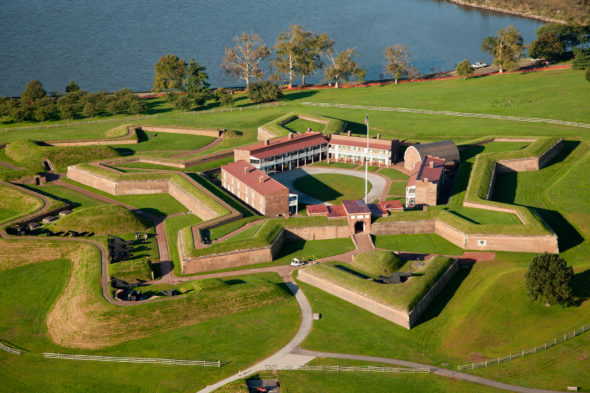Baltimore gears up to enjoy Star-Spangled Banner’s 200th anniversary
Daily News Article — Posted on September 10, 2014
Flag that flew over Fort McHenry during its bombardment in 1814, which was witnessed by Francis Scott Key. The flag was kept by the family of Major Armistead, the commander of the fort, until being donated to the Smithsonian in 1912.
“The Star-Spangled Banner” is the national anthem of the United States. The lyrics come from “Defense of Fort McHenry”, a poem written in 1814 by the 35-year-old lawyer and amateur poet Francis Scott Key after witnessing the bombardment of Fort McHenry by British ships of the Royal Navy in the Chesapeake Bay during the Battle of Fort McHenry in the War of 1812.
(PennLive, The Patriot-News) – Baltimore is set to celebrate the 200th anniversary of Francis Scott Key’s penning of “The Star-Spangled Banner” in events this week.
Jotted on the back of a letter by Key as he sat in the midst of a 25-hour British bombardment of Fort McHenry in 1814, the poem captured what 50,000 terrified Baltimoreans felt as they watched from Federal Hill and city rooftops.

Francis Scott Key
They feared the British would overtake the fort and burn their city as had happened three weeks earlier in Washington, D.C.
But as an enormous flag was hoisted over Fort McHenry early the morning of September 14, 1814, and the Brits prepared to depart, everyone sighed with relief.
Key’s four-verse poem was printed as a leaflet and widely circulated. But didn’t become our national anthem until 1931, 117 years after it was written.
From September 10-16, Baltimore will hold events to celebrate the bicentennial as more than 30 tall ships and naval vessels sail into the harbor, as the Navy’s Blue Angels soar overhead, as concerts, military bands, cannon firings, festivals and more than 1 million visitors fill the town for a Star Spangled Spectacular.
The celebration will be capped off by a spectacular display of pyrotechnic fireworks on September 13 by the Grucci family. The show will be launched from six barges stretching three miles from the Inner Harbor to Fort McHenry.
Fort McHenry a focus
Although events will take place all over the city, all eyes will be on the Fort McHenry National Monument where special events and presentations are planned each day from September 9-16.

Fort McHenry National Monument
A complete rundown of those activities is available on a special web site. (See “Background” below the questions.)
For example, on Tuesday, September 9, 7000 red, white and blue-clad school students from every county in Maryland formed the largest living flag ever created. (Video available shortly at: starspangledbannerlivingflag.org)
Today more than 30 naval vessels and tall ships from seven countries will sail past the fort on their way to the Inner Harbor where they’ll dock so you can tour them.
Over the weekend of September 13-14, admission to the fort will be free. It will come alive with soldiers, sailors and citizens from 1814. There will be campfires, women in long skirts boiling clothes in copper kettles over hot fires, fifes and drums, food, and children’s activities.
Three of the fort’s cannons will be shot off during the weekend celebration. “One gun is deafening,” said Ranger Jim Bailey. “The fort had 60 guns in 1814.”
Visitors can help raise the flag on a flagpole located in the same spot as it was during the battle. The flag has been flying there continuously since 1948 when President Truman ordered that it be flown, 24/7, over Fort McHenry.
On Saturday and Sunday afternoons there will be air shows from 2-4 p.m. featuring the Navy’s Blue Angels flight demonstration squadron. Military bands will play, the Fort McHenry Guard will perform, elected officials will speak and then the fireworks.
Also on the night of September 13 a two-hour ticketed concert will be held at the city’s Pier Six Pavilion. Hosted by actor, musician and author John Lithgow and co-hosted by platinum recording artist and actress Jordin Sparks, it will be broadcast live on PBS’s Great Performances.
Reprinted here for educational purposes only. May not be reproduced on other websites without permission from PennLive (The Patriot-News. Visit the website at pennlive.com.
Background
For a brief history of the writing of the Star Spangled Banner, go to: starspangled200.com/star-spangled-stories/the-national-anthem
For all information on the 200th anniversary of the Star Spangled Banner, go to starspangled200.com.
Read a brief history of the war of 1812 at: ussconstitutionmuseum.org/about-us/bicentennial/short-history-1812 and at wikipedia.
- Beginning at 6:00 a.m. on September 13, 1814, British warships under the command of Vice Admiral Alexander Cochrane continuously bombarded Fort McHenry for 25 hours.
- The American defenders had 18, 24, and 38-pound cannons with a maximum range of 1.5 miles. The British guns had a range of 2 miles, and their rockets had a 1.75-mile range, but neither guns nor rockets were accurate.
- The British ships were unable to pass Fort McHenry and penetrate Baltimore Harbor because of its defenses, including a chain of 22 sunken ships, and the American cannons. They were, however, able to come close enough at maximum range to fire rockets and mortars at the fort.
- Due to the poor accuracy of the British weapons at maximum range, and the limited range of the American guns, very little damage was done on either side before the British ceased their attack on the morning of September 14 due to a lack of ammunition. Thus the naval part of the British invasion of Baltimore had been repulsed.
- Only one British warship, a bomb vessel, received a direct hit from the fort's return fire, which wounded one crewman.
- The Americans were under the command of Major George Armistead. They did suffer casualties, amounting to four killed and 24 wounded, including one African-American soldier and a woman who was cut in half by a bomb as she carried supplies to the troops.
- At one point during the bombardment, a bomb crashed through the fort's powder magazine. Fortunately for the defenders, either the fuse was extinguished by the rain or the bomb was merely a dud.
- Francis Scott Key, a Washington lawyer who had come to Baltimore to negotiate the release of Dr. William Beanes, a civilian prisoner of war, witnessed the bombardment from a nearby truce ship.
- An oversized American flag had been sewn by Mary Pickersgill for $405.90 in anticipation of the British attack on the fort. When Key saw the flag emerge intact in the dawn of September 14, he was so moved that he began that morning to compose the poem "Defense of Fort McHenry" which would later be renamed "The Star-Spangled Banner" and become the United States' national anthem. (from wikipedia)
Visit c-span for video of the anniversary events.

